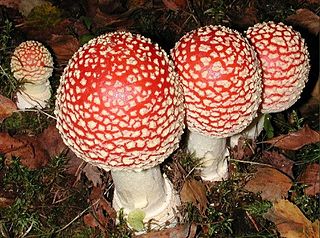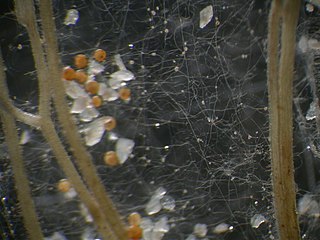
A mycorrhiza is a symbiotic association between a fungus and a plant. The term mycorrhiza refers to the role of the fungus in the plant's rhizosphere, its root system. Mycorrhizae play important roles in plant nutrition, soil biology, and soil chemistry.

Convolvulaceae, commonly called the bindweeds or morning glories, is a family of about 60 genera and more than 1,650 species. These species are primarily herbaceous vines, but also include trees, shrubs and herbs. The tubers of several species are edible, the best known of which is the sweet potato.

An arbuscular mycorrhiza (AM) is a type of mycorrhiza in which the symbiont fungus penetrates the cortical cells of the roots of a vascular plant forming arbuscules.

Glomeromycota are one of eight currently recognized divisions within the kingdom Fungi, with approximately 230 described species. Members of the Glomeromycota form arbuscular mycorrhizas (AMs) with the thalli of bryophytes and the roots of vascular land plants. Not all species have been shown to form AMs, and one, Geosiphon pyriformis, is known not to do so. Instead, it forms an endocytobiotic association with Nostoc cyanobacteria. The majority of evidence shows that the Glomeromycota are dependent on land plants for carbon and energy, but there is recent circumstantial evidence that some species may be able to lead an independent existence. The arbuscular mycorrhizal species are terrestrial and widely distributed in soils worldwide where they form symbioses with the roots of the majority of plant species (>80%). They can also be found in wetlands, including salt-marshes, and associated with epiphytic plants.

The Tremellomycetes are a class of dimorphic fungi in the Agaricomycotina. Some species have gelatinous basidiocarps or (microscopically) a sacculate parenthesome. There are six orders, 17 families, and 39 genera in the Tremellomycetes. Tremellomycetes include yeasts, dimorphic taxa, and species that form complex fruiting bodies. Tremellomycetes include some fungi that are human and animal pathogens in the genera Cryptococcus, Naganishia, Papiliotrema, and Trichosporon and some fungi that are cultivated for food in the genera Tremella and Naematelia.
The Cystofilobasidiales are an order of fungi in the class Tremellomycetes of the Basidiomycota. They usually exhibit a life phase of free-living yeasts. The order contains two families with seven genera and some 25 species.

The Tremellales are an order of fungi in the class Tremellomycetes. The order contains both teleomorphic and anamorphic species, most of the latter being yeasts. All teleomorphic species in the Tremellales are parasites of other fungi, though the yeast states are widespread and not restricted to hosts. Basidiocarps, when produced, are gelatinous.
The Cuniculitremaceae are a family of fungi in the order Tremellales. There are three genera in the family. Sterigmatosporidium polymorphum parasitizes other fungi growing in insect galleries in wood. It does not produce basidiocarps, but has septate basidia similar to those found in the genus Tremella. Most species are known only from their yeast states.
The Agaricostilbomycetes are a class of fungi in the subdivision Pucciniomycotina of the Basidiomycota. The class consists of a single order, six families, and 15 genera. Most species are known only from their yeast states. Where known, basidiocarps (fruitbodies) are typically small and stilboid (pin-shaped).
The Filobasidiaceae are a family of fungi in the order Filobasidiales. Most species are yeasts, but some form gelatinous fruit bodies that are parasitic on other fungi, including lichens. The family currently contains five genera.
Filobasidium is a genus of fungi in the family Filobasidiaceae. Most species are only known from their yeast states, but some produce hyphae with haustorial cells, indicating that they are parasites of other fungi. Basidia are tubular with terminal, sessile basidiospores. Basidiocarps are not formed.
Bulleribasidium is a genus of fungi in the family Bulleribasidiaceae. The genus currently contains some eleven species. The type species is a parasite of other fungi, its teleomorph having septate basidia and haustorial cells on its hyphae that connect to the host hyphae. Most species are, however, only known from their yeast states.
The Chionosphaeraceae are a family of fungi in the order Agaricostilbales. The family contains six genera. Some species form small, stilboid (pin-shaped) fruitbodies. Others are known only from their yeast states.
Naganishia is a genus of fungi in the family Filobasidiaceae. Species are currently only known from their yeast states, most of which were formerly referred to the genus Cryptococcus. Some 15 species have been described worldwide. Naganishia albida is an occasional human pathogen.
The Cryptococcaceae are a family of fungi in the order Tremellales. The family currently contains two genera. Some species produce filamentous, sexual states with distinctive basidia and are parasites of other fungi. Most, however, are only known from their yeast states. Several species of Cryptococcus are human pathogens.
The Bulleraceae are a family of fungi in the order Tremellales. The family currently contains five genera. Some species produce gelatinous basidiocarps and were formerly placed in the genus Tremella. Most, however, are only known from their yeast states.
The Bulleribasidiaceae are a family of fungi in the order Tremellales. The family currently contains six genera. Some species produce filamentous sexual states with septate basidia and are parasites of other fungi. Most, however, are only known from their yeast states.
The Piskurozymaceae are a family of fungi in the order Filobasidiales. Most species are only known from their yeast states, but some produce filamentous sexual states with basidia that are parasitic on other fungi. The family currently contains two genera.
The Rhynchogastremaceae are a family of fungi in the order Tremellales. The family currently contains two genera. Some species produce filamentous sexual states with septate basidia and are parasites of other fungi. Most, however, are only known from their yeast states.
The Trimorphomycetaceae are a family of fungi in the order Tremellales. The family currently contains four genera. Some species produce filamentous sexual states and are parasites of other fungi. Most, however, are only known from their yeast states.






